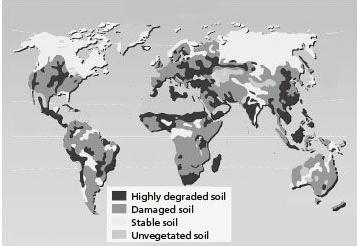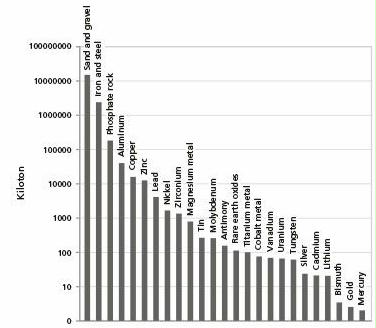 FIGURE 1. The state of soil health globally.
FIGURE 1. The state of soil health globally.
Preface. Ugo Bardi’s book on minerals covers a wide-ranging territory, including soil, which is a mineral. In this section of the book he shows how humans have damaged the soil so much we have greatly overshot carrying capacity by lowering its capacity to grow food, and he explains why there is no way to fix this with GMO crops or other solutions.
Here are 7 other posts from this great book:
- Mining: Waste, Pollution, Destruction
- Ugo Bardi predictions of the future
- Minerals and War
- Minerals: Natural gas
- Minerals: Coal
- Mineral: Soil
- Peak Uranium
Alice Friedemann www.energyskeptic.com Author of Life After Fossil Fuels: A Reality Check on Alternative Energy; When Trucks Stop Running: Energy and the Future of Transportation”, Barriers to Making Algal Biofuels, & “Crunch! Whole Grain Artisan Chips and Crackers”. Women in ecology Podcasts: WGBH, Jore, Planet: Critical, Crazy Town, Collapse Chronicles, Derrick Jensen, Practical Prepping, Kunstler 253 &278, Peak Prosperity, Index of best energyskeptic posts
***
Bardi, Ugo. 2014. Extracted: How the Quest for Mineral Wealth Is Plundering the Planet. Chelsea Green Publishing.
Today, it is estimated that the land biosphere produces 56 billion tons of new biomass every year. Of the elements that are part of this mass, most come from the atmosphere, but about 1% must be extracted from the ground. Therefore, plants are mining about half a billion tons of materials from the crust every year. The cycle is very efficient: plants have never been in danger of “running out” of minerals at the planetary scale.
Nowadays humans extract from the ground several billion tons of materials every year. We use all 88 of the elements present in the Earth’s crust and even unstable elements that didn’t exist on Earth in measurable amounts before we started creating them. We dig at depths unthinkable for plant roots: our mines are hundreds of meters deep and our drills reach tens of kilometers into the crust, even under the sea.
Soil Fertility and Human Survival
Perhaps our most important source of minerals can be found in the rich, complex ecosystem that blankets most of the Earth’s land surface: soil. This all-important organic matter was formed over thousands of years as rock broke down into tiny particles that were gradually infiltrated by living organisms. Running anywhere between a few centimeters and several meters deep, soil sustains a diverse mix of plants and animals that forever change it as they live and die. It is moved about by wind, water, ice, and gravity—sometimes slowly, sometimes rapidly. As history has shown us, it can make or break civilizations. It’s little surprise that many ancient civilizations began where the topsoil was richest and farming was most productive. But many of these civilizations mismanaged the soil, and as their agricultural productivity declined, so did their civilizations. Occasionally they vanished entirely. Studies suggest that the 1,700-year-old Mayan civilization in South America collapsed around 900 CE because its fertile ground eroded away due to bad soil management. 3 Soil and survival are so intricately entwined because fertile soil supplies most of the elements that higher plants need to support photosynthesis and other metabolic processes.
Soil depletion occurs in many ways. In agriculture, depletion can result from excessively intense cultivation and inadequate soil management. For instance, in tropical zones where the nutrient content of soils is low, widespread soil depletion has resulted from over-tilling (which damages the soil structure), insufficient nutrient inputs (which leads to mining of the soil’s nutrient bank), and salinization.
The combined effects of growing population density, large-scale industrial logging, slash-and-burn agriculture, ranching, and other factors have in some places reduced soil fertility to nearly zero. In fact, billions of tons of soil are being physically lost each year.
The most serious losses arise from erosion— the washing or blowing away of surface soil, sometimes down to bedrock.
While some erosion takes place naturally, without human help, natural soil loss and new soil creation normally stay in balance. However, the rates of soil erosion associated with agricultural practices are accelerating, to the point of exceeding soil-loss tolerances over most of the Earth’s cropland regions.
The irrigation systems that have played an important role in increasing crop production have also had negative impacts on soil quality, with some researchers estimating that excessive watering has caused salinization.
As figure 2.1 shows, the Food and Agriculture Organization (FAO) of the United Nations estimates that 34 million hectares (Mha), or 11% of irrigated areas, are affected by some level of salinization, with China, the United States, and India representing more than 60 percent, 21 million hectares (Mha), of the total impacted land.
An additional 60 to 80 Mha are affected to some extent by water logging and related salinity.
The uncontrolled application of chemical and industrial wastes has degraded soil as well.
Not all soil loss is from farming, though. Millions of hectares of what would otherwise be good farmland are being flooded for reservoirs or paved over for highways, airports, parking lots, and expanding urban areas. Agriculture is also experiencing rising competition from fast-growing cities and urban settlements, resulting in smaller areas of productive agricultural land at a time when world population is growing and expectations are rising among people everywhere for a better life. Global warming, too, is expected to increase the rate of nutrient loss in soils, since microbial decomposition occurs faster under warmer temperatures.
The Impact on Food Supply
The world is facing a series of challenges to human survival. Water is growing increasingly scarce, water pollution is becoming more widespread, and water-related ecosystems are degrading. Global warming, air and land pollution, and the depletion of natural and mineral resources are escalating. These are all serious threats to human welfare, but the loss of suitable land and soil quality for agricultural production is no less important and no less serious.
The total land area of the world exceeds 13.2 billion hectares, but less than half of it can be used for agriculture, including grazing. The remainder is either too wet or too dry, too shallow or too rocky. The single most serious drawback to farming additional land is generally lack of water. In addition, some land is toxic, some is deficient in the nutrients that plants require, and some is permanently frozen.
A report of the Natural Resources Conservation Service of the US Department of Agriculture showed that:
- Some of the world’s land productivity has declined by 50 percent.
- Desertification can be observed on 33 percent of the global land surface and affects more than one billion people, half of whom live in Africa.
- Crop yield reduction in Africa due to past soil erosion may range between 2 and 40 percent, with a mean total loss of 8.2% for the continent.
The report estimated that in 2001 southern Asia lost an estimated 36 million tons, or $5.4 billion, of cereal production to water erosion and $1.8 billion to wind erosion. On a global scale the annual loss of 75 billion tons of soil costs the world about $400 billion per year.
Unfortunately, there are no simple solutions to these gigantic, complex problems. We cannot expect that technology will come to the rescue with some miracle crop. The so-called green revolution that took place during the second half of the 20th century did increase crop yields, but in the process it used large amounts of artificial fertilizers and crops that required increased amounts of pesticides in order to survive.
The productivity of the land is limited by basic factors such as the efficiency of natural photosynthesis, which cannot be modified by humans—not even by using fancy GMO crops. We must recognize that we are in a state of deep overshoot for practically all the natural resources available to us.
What we are facing may be no different from the fate of many civilizations of the past. When farm productivity declined, society attempted to maintain production by expanding the land base under cultivation and putting more effort into cultivating the depleted areas. That led to accelerated soil loss, which became a major factor in the collapse of entire civilizations—such as the Mayan one.

Figure 2.1 World production of some mineral commodities in 2010 based on data from the British Geological Survey
Figure 2.1 shows some data for the total minerals produced in 2010. This amount becomes even larger if we consider the “extraction” of fertile soil in agriculture—consumed by erosion—as mining. It is estimated that about 4 billion tons of agricultural soil is eroded in the United States and dumped into the oceans every year. 61 Global estimates have ranged from 75 billion tons per year to 120 billion tons. 62 These amounts dwarf those created by natural erosion, which is at least one order of magnitude smaller.
